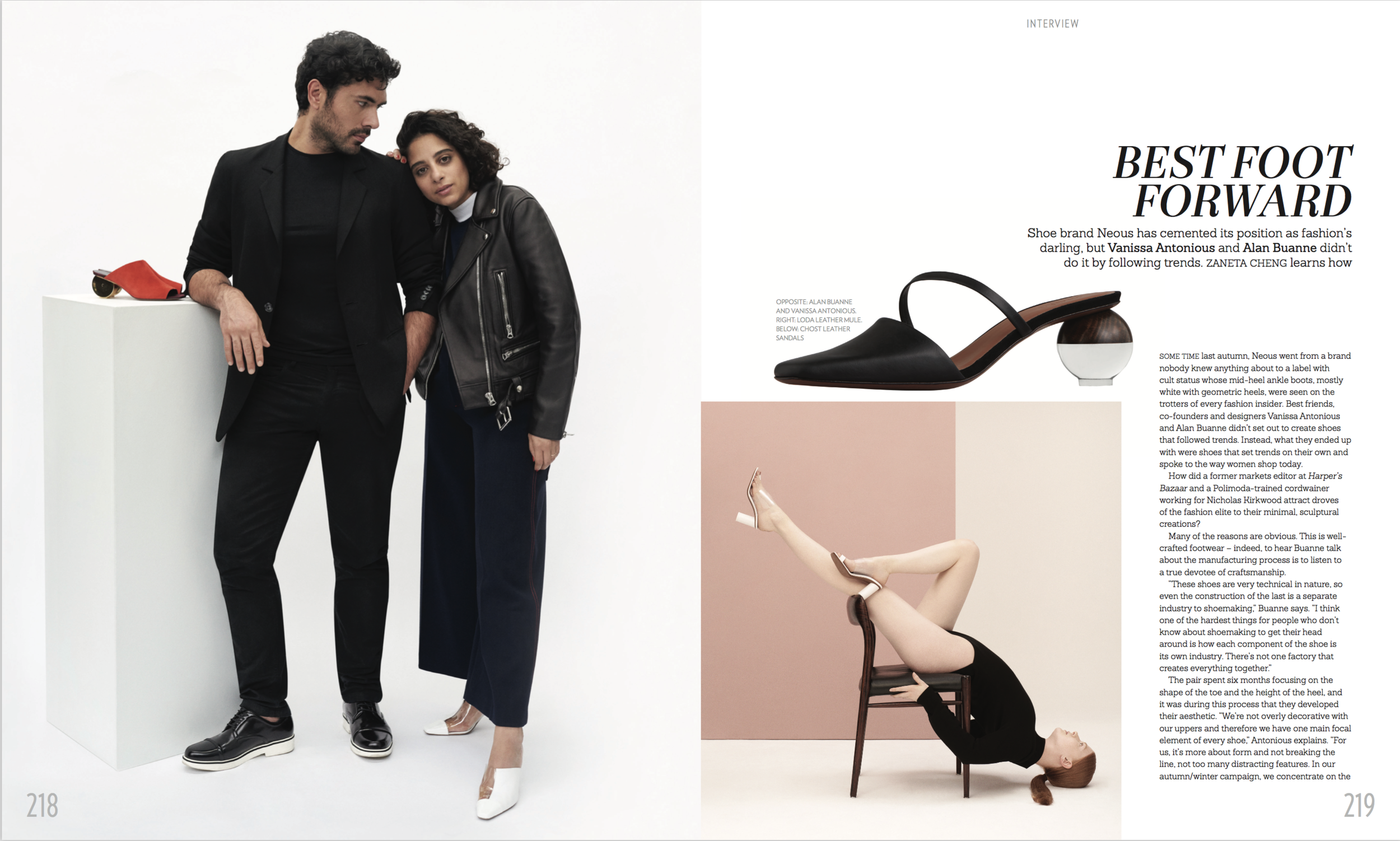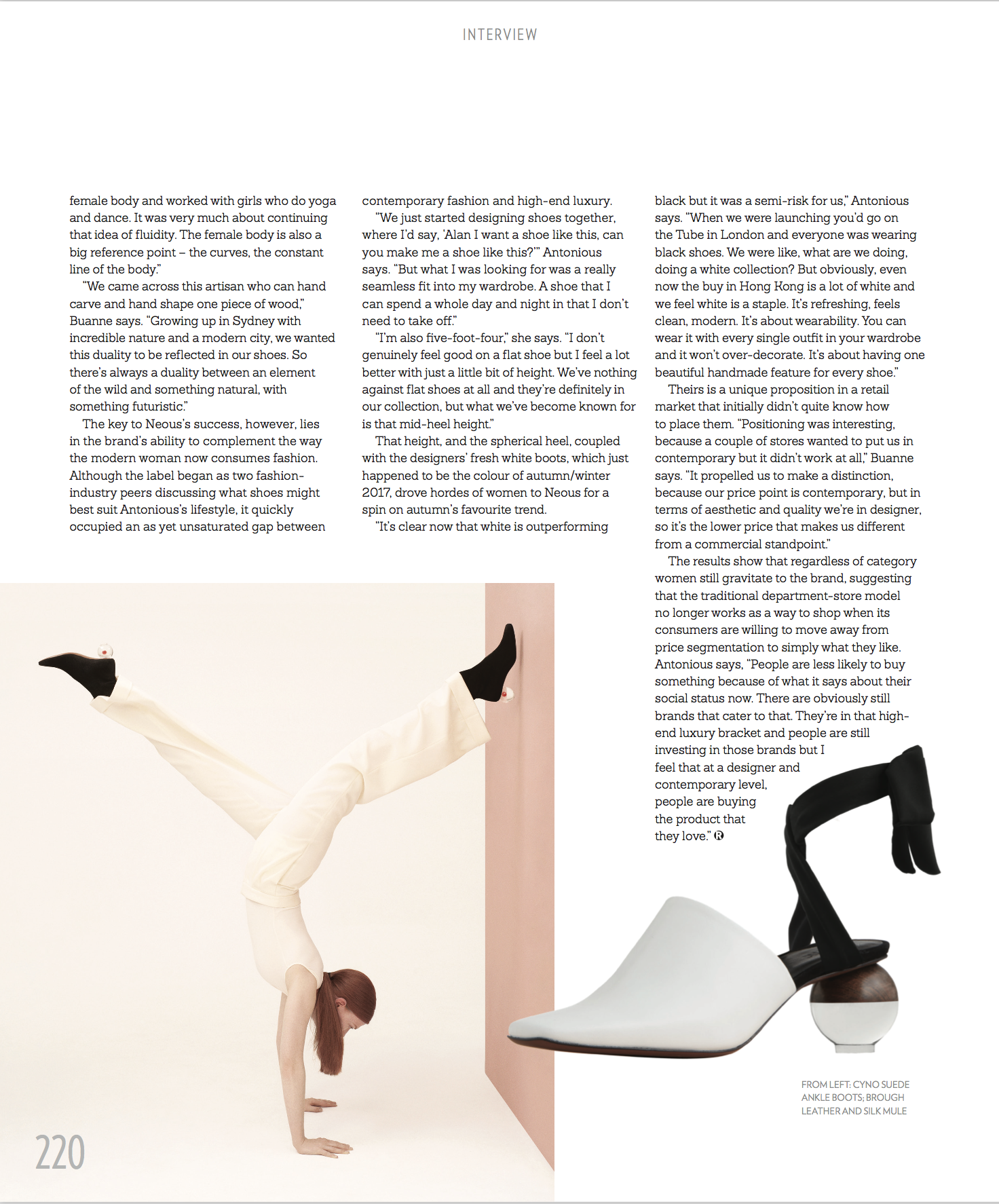Neous | Prestige Hong Kong (Sept 18)
Shoe brand Neous has cemented its position as fashion’s darling, but Vanissa Antonious and Alan Buanne didn’t do it by following trends. zaneta cheng learns how
Some time last autumn, Neous went from a brand nobody knew anything about to a label with cult status whose mid-heel ankle boots, mostly white with geometric heels, were seen on the trotters of every fashion insider. Best friends, co-founders and designers Vanissa Antonious and Alan Buanne didn’t set out to create shoes that followed trends. Instead, what they ended up with were shoes that set trends on their own and spoke to the way women shop today.
How did a former markets editor at Harper’s Bazaar and a Polimoda-trained cordwainer working for Nicholas Kirkwood attract droves of the fashion elite to their minimal, sculptural creations?
Many of the reasons are obvious. This is well-crafted footwear – indeed, to hear Buanne talk about the manufacturing process is to listen to a true devotee of craftsmanship.
“These shoes are very technical in nature, so even the construction of the last is a separate industry to shoemaking,” Buanne says. “I think one of the hardest things for people who don’t know about shoemaking to get their head around is how each component of the shoe is its own industry. There’s not one factory that creates everything together.”
The pair spent six months focusing on the shape of the toe and the height of the heel, and it was during this process that they developed their aesthetic. “We’re not overly decorative with our uppers and therefore we have one main focal element of every shoe,” Antonious explains. “For us, it’s more about form and not breaking the line, not too many distracting features. In our autumn/winter campaign, we concentrate on the female body and worked with girls who do yoga and dance. It was very much about continuing that idea of fluidity. The female body is also a big reference point – the curves, the constant line of the body.”
“We came across this artisan who can hand carve and hand shape one piece of wood,” Buanne says. “Growing up in Sydney with incredible nature and a modern city, we wanted this duality to be reflected in our shoes. So there’s always a duality between an element of the wild and something natural, with something futuristic.”
The key to Neous’s success, however, lies in the brand’s ability to complement the way the modern woman now consumes fashion. Although the label began as two fashion-industry peers discussing what shoes might best suit Antonious’s lifestyle, it quickly occupied an as yet unsaturated gap between contemporary fashion and high-end luxury.
“We just started designing shoes together, where I’d say, ‘Alan I want a shoe like this, can you make me a shoe like this?’” Antonious says. “But what I was looking for was a really seamless fit into my wardrobe. A shoe that I can spend a whole day and night in that I don’t need to take off.”
“I’m also five-foot-four,” she says. “I don’t genuinely feel good on a flat shoe but I feel a lot better with just a little bit of height. We’ve nothing against flat shoes at all and they’re definitely in our collection, but what we’ve become known for is that mid-heel height.”
That height, and the spherical heel, coupled with the designers’ fresh white boots, which just happened to be the colour of autumn/winter 2017, drove hordes of women to Neous for a spin on autumn’s favourite trend.
“It’s clear now that white is outperforming black but it was a semi-risk for us,” Antonious says. “When we were launching you’d go on the Tube in London and everyone was wearing black shoes. We were like, what are we doing, doing a white collection? But obviously, even now the buy in Hong Kong is a lot of white and we feel white is a staple. It’s refreshing, feels clean, modern. It’s about wearability. You can wear it with every single outfit in your wardrobe and it won’t over-decorate. It’s about having one beautiful handmade feature for every shoe.”
Theirs is a unique proposition in a retail market that initially didn’t quite know how to place them. “Positioning was interesting, because a couple of stores wanted to put us in contemporary but it didn’t work at all,” Buanne says. “It propelled us to make a distinction, because our price point is contemporary, but in terms of aesthetic and quality we’re in designer, so it’s the lower price that makes us different from a commercial standpoint.”
The results show that regardless of category women still gravitate to the brand, suggesting that the traditional department-store model no longer works as a way to shop when its consumers are willing to move away from price segmentation to simply what they like. Antonious says, “People are less likely to buy something because of what it says about their social status now. There are obviously still brands that cater to that. They’re in that high-end luxury bracket and people are still investing in those brands but I feel that at a designer and contemporary level, people are buying the product that they love.”

